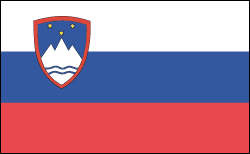SLOVENIA

Geography: Slovenia occupies an area about the size of the state of Massachusetts. It is largely a mountainous republic and almost half of the land is forested, with hilly plains spread across the central and eastern regions. Mount Triglav, the highest peak, rises to 9,393 ft (2,864 m).
Government: Parliamentary democratic republic.
History: Slovenia was originally settled by Illyrian and Celtic peoples. It became part of the Roman Empire in the first century B.C.
The Slovenes were a south Slavic group that settled in the region in the 6th century A.D. During the 7th century, the Slavs established the state of Samu, which owed its allegiance to the Avars, who dominated the Hungarian plain until Charlemagne defeated them in the late 8th century.
When the Hungarians were defeated by the Turks in 1526, Hungary accepted Austrian Hapsburg rule in order to escape Turkish domination; the Hapsburg monarchy was the first to include all of the Slovene regions. Thus, Slovenia and Croatia became part of the Austro-Hungarian kingdom when the dual monarchy was established in 1867. Like Croatia and unlike the other Balkan states, it is primarily Roman Catholic.
Following the defeat and collapse of Austria-Hungary in World War I, Slovenia declared its independence. It formally joined with Montenegro, Serbia, and Croatia on Dec. 4, 1918, to form the new nation called the Kingdom of the Serbs, Croats, and Slovenes. The name was later changed to Yugoslavia in 1929.
During World War II, Germany occupied Yugoslavia, and Slovenia was divided among Germany, Italy, and Hungary. For the duration of the war many Slovenes fought a guerrilla war against the Nazis under the leadership of the Croatian-born Communist resistance leader, Marshal Tito. After the final defeat of the Axis powers in 1945, Slovenia was again made into a republic of the newly established Communist nation of Yugoslavia.

Map of Slovenia
President: Borut Pahor (2012)
Prime Minister: Miro Cerar
(2014)
Land area: 7,780 sq mi (20,151 sq km);
total area: 7,827 sq mi (20,273 sq km)
Population (2014 est.): 1,988,292 (growth
rate: -0.23%); birth rate: 8.54/1000; infant mortality rate: 4.04/1000;
life expectancy: 77.83
Capital and largest city (2011 est.):
Ljubljana 273,000
Monetary unit: Slovenian tolar; euro (as of
1/1/07)
National
name: Republika Slovenija
Languages:
Slovenian 91.1%, Serbo-Croatian 4.5%, other or unspecified 4.4% (2002)
Ethnicity/race:
Slovene 83.1%, Serb 2%, Croat 1.8%, Bosniak 1.1%, other or unspecified 12% (2002 census)
Religions:
Catholic 57.8%, Muslim 2.4%, Orthodox 2.3%,
other Christian 0.9%, unaffiliated 3.5%, other or unspecified 23%, none
10.1% (2002 census)
Literacy rate:
99.7% (2011 est.)
Economic summary:
GDP/PPP (2013 est.): $57.36 billion; per capita $27,400.
Real growth rate: -1.1%. Inflation: 1.8%.
Unemployment: 13.1%. Arable land: 8.31%. Agriculture:
potatoes, hops, wheat, sugar beets, corn, grapes; cattle, sheep,
poultry. Labor force: 934,700 (2011 est.); agriculture 2.2%, industry 35%,
services 62.8% (2019). Industries: ferrous metallurgy and
aluminum products, lead and zinc smelting; electronics (including
military electronics), trucks, electric power equipment, wood
products, textiles, chemicals, machine tools. Natural
resources: lignite coal, lead, zinc, building stone,
hydropower, forests. Exports: $28.73 billion (2013 est.): manufactured goods, machinery and transport equipment,
chemicals, food. Imports: $29.49 billion (2013 est.):
machinery and transport equipment, manufactured goods, chemicals,
fuels and lubricants, food. Major trading partners: Germany,
Italy, Austria, France, Croatia, Russia, Hungary (2012).
Communications: Telephones: main lines in
use: 825,000 (2012); mobile cellular: 2.246 million (2012). Broadcast media: Public
television broadcaster, Radiotelevizija Slovenija (RTV), operates a
system of national and regional TV stations; 35 domestic commercial
television stations operating nationally, regionally, and locally; about
60% of households are connected to multi-channel cable TV systems;
public radio broadcaster operates 3 national and 4 regional stations;
more than 75 regional and local commercial and non-commercial radio
stations (2007). Internet Service Providers
(ISPs): 415,581 (2012). Internet users: 1.298 million (2009).
Transportation: Railways: total: 1,228 km
(2007). Highways: total: 38,985; paved: 38,985 km (includes 769 km of expressways) (2012). Waterways:
(there is some transport on the Drava River) (2012). Ports and harbors: Koper.
Airports: 16 (2013).
International
disputes: since the breakup of Yugoslavia in the early
1990s, Croatia and Slovenia have each claimed sovereignty over Pirin Bay
and four villages, and Slovenia has objected to Croatia's claim of an
exclusive economic zone in the Adriatic Sea; in 2009, however Croatia
and Slovenia signed a binding international arbitration agreement to
define their disputed land and maritime borders, which led to Slovenia
lifting its objections to Croatia joining the EU; as a member state that
forms part of the EU's external border, Slovenia has implemented the
strict Schengen border rules to curb illegal migration and commerce
through southeastern Europe while encouraging close cross-border ties
with Croatia; Slovenia continues to impose a hard border Schengen regime
with Croatia, which joined the EU in 2013 but has not yet fulfilled
Schengen requirements.
-------------------- o --------------------
No comments:
Post a Comment